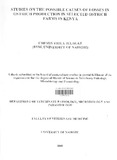| dc.description.abstract | Commercial ostrich farming is rapidly becoming a desirable alternative source of
profitable meat production among small holder farmers in Kenya. However ostrich
farming in the country is severely constrained by high egg losses (up to 60%) and chick
mortality rate (up to 40%). The overall aim of this study was to establish the possible
causes of egg and chick losses in ostrich production in Kenya. The study was carried out
in Maasai Ostrich Farm (MOF) in Kitengela and Ostree Ostrich Farm (OOF) in Naivasha.
It involved i) examining the incubation parameters and egg weight losses during
incubation, ii) performing post-mortem examinations on un-hatched embryos and dead
chicks, iii) investigating parasitological status of the birds and iv) establishing the
management practices at farm level regarding disease control, handling and incubation of
eggs, management of newly hatched chicks and relating these to overall production
performance.
Results of the study showed that optimum hygienic conditions were maintained within
the incubation and hatchery facility at MOF. The average percentage egg weight loss
during the incubation period was 10.2%. The automated incubator used was always set
and maintained at a temperature of 36°C and 30% relative humidity. Abnormalities in the
yolk were common phenomenon in the embryos (with poor embryo development and
those dead in shell). Changes in the yolk included deviations in colour and consistency.
The colours varied from yellowish brown, brownish, yellowish green, green and dark
green, whereas the consistency was either semi-solid or solid. Other findings included
Xll
subcutaneous gelatinous oedema of embryos and chicks. An average of 62.5% of the
adult birds' small intestines had tapeworm infection with Houttuynia struthionis. Out of
those infested, 60% had severe haemorrhagic enteritis, while 20% had moderate and
another 20% had mild haemorrhagic enteritis respectively. In addition, the small
intestines observed histopathology showed atrophy of the villi, glandular distortion and
inflammatory cell infiltration. The inflammatory cells observed were mainly lymphocytes
and heterophils. Mites and flies collected from feathers of the slaughtered birds were
identified as Struthiopterolichus bicaudatus and pseudolynchia canariensis, respectively.
The ostrich quill mite cause irritation, leading to excessive preening, feather loss,
reduction in leather quality and predisposition to secondary infection and gastrointestinal
disorders. Pseudolynchia canariensis when in high numbers also irritate the birds,
causing them to be restless hence interfere with their feeding and resting time.
The average egg weight loss during incubation at MOF was below the normal
documented range and there was high prevalence of endoparasites and ectoparasites
observed. Trained personnel and routine recordings of egg weights during incubation
were recommended in keeping track of progressive egg weight loss at the farm. Routine
treatments of the birds to prevent tapeworms and quill mites that will deprive off essential
nutrients as well as interfere with the birds feeding time and comfort is important. | en |

